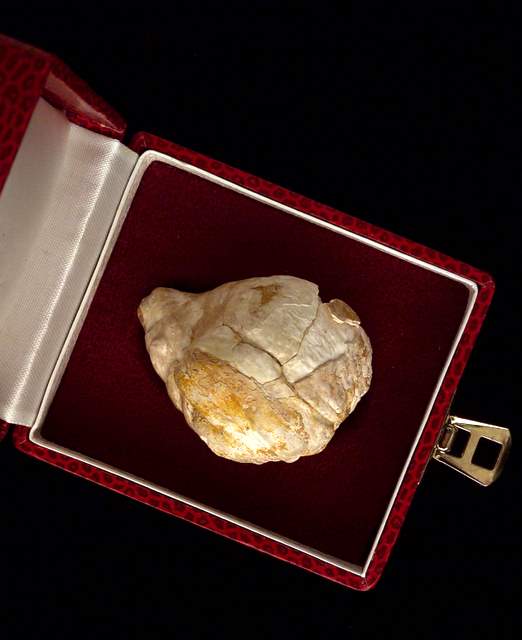Largest Known Fossil Pearl
Vienna, Austria
This is the largest fossil pearl known so far.
It is said to be 16.5 million years old (Miocene), from the Korneuburg Basin near Vienna in Austria and was formed by a giant Perna aquitanicus as a blister pearl due to the boring attack of a drilling bivalve. Its diameter is nearly 5 cm.
The Geological-Paleontological Department of the Natural History Museum in Vienna is currently planning a big geo-park which focuses on a Miocene oyster reef of 400 square-metre. Within that structure, several years ago, the largest known fossil pearl was found. It’s a blister-pearl of 5 cm diameter from a mytilid bivalve. This will be one of the highlights of the exhibition. May 8, 2009, is the opening date for this exhibition.

Large 5cm Fossil Pearl Photo used with permission
copyright Natural History Museum Vienna
The fossil pearl was found in the 1970ies by a collector at Stetten – a small village close to Vienna in Austria. It formed during the Miocene epoch within the giant mussel Perna aquitanica. Its growth was triggered by the drilling action of a Gastrochaena bivalve which penetrated the mussel-shell. Thus, the pearl is a blister pearl which was still in situ. The paleo-environment, some 16.5 million years ago, was a tropical estuary with swamp forests, scattered mangroves and extended oyster reefs along the muddy shores. Even these oysters have been giants at that time, reaching up to 100 cm in length! Surprisingly, these oysters, which grew in enormous masses, did not produce pearls in noteworthy amounts. A singly tiny blister-pearl was found in one of the oysters during an excavation campaign of the Natural History Museum Vienna in 2008. In contrast, the mussel Perna was prone to pearl formation and small pearls have been detected several times in the surrounding sediment.
The huge fossil pearl and its smaller counterpart from the oyster are on display in the geopark “Fossilienwelt Weinviertel”. The main attraction in that geotainment park, however, is a 400 square metre large and 25° tilted fossil tidalflat with c. 20.000 giant oysters. More than 200 volunteers have been working for about 17.000 hours to excavate and clean this unique natural monument. Scientists interpret this oyster “battle-field” to be a relic of a Tsunami which had destroyed large parts of the estuary.
More information:
Harzhauser, M., Sovis, W. & Schmid, B. 2006a. Die Perltaucher von Korneuburg. – Universum, 3, NHMW 4-6. (German)
Harzhauser, M., Böhme, M., Mandic, O. & Hofmann, Ch.-Ch. (2002): The Karpatian (Late Burdigalian) of the Korneuburg Basin - A Palaeoecological and Biostratigraphical Synthesis. - Beiträge zur Paläontologie, 27: 441-456, Wien.
Latal, C., Piller, W.E. & Harzhauser, M. 2006. Small-scaled environmental changes: indications from stable isotopes of gastropods (Early Miocene, Korneuburg Basin, Austria) - International Journal of Earth Sciences 95: 95-106, doi: 10.1007/s00531-005-0510-3.
Thanks to Dr. Mathias Harzhauser, Head Geological-Paleontological Department,
Natural History Museum Vienna, for this information.
See more famous pearls after reading about this giant fossil pearl.
Enjoy this page? Please pay it forward. Here's how...
Would you prefer to share this page with others by linking to it?
- Click on the HTML link code below.
- Copy and paste it, adding a note of your own, into your blog, a Web page, forums, a blog comment, your Facebook account, or anywhere that someone would find this page valuable.